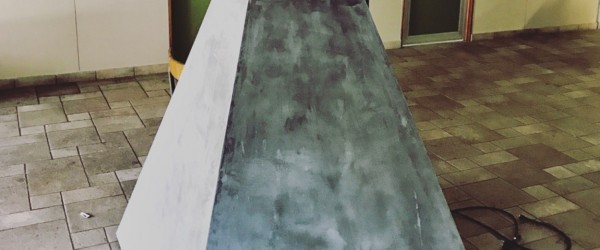The State of Things 2017

The State of Things by Pieter Van Bogaert
Overtoon and Werktank, they are communicating vessels. The first works with sound, in the Northern Quarter of Brussels, on the 25th floor of the abandoned WTC building. The second works with visual art, in the heart of Leuven. And we all know: sound and vision, they are not indifferent to each other. That's what you also see in their work, in which sound artists think about the image and visual artists collaborate with musicians. You also notice it in the movements of the artists who, depending on the emphasis in their work, work with either one or the other organization. You can also see it in this exhibition, the third in three years, in which Overtoon and Werktank give an insight into their activities: The State of Things.
The State of Things is a snapshot. It's a demonstration: it shows another reality. It is about producing: it shows a process. It is about presenting: it shows things that pass from one state to another while you look at it. It is about research: about the intermediate zone in which another way of watching and listening creates a different experience.
The way in which Floris Vanhoof equals the sound of a symphonic orchestra with forty geometrically-shaped loudspeakers: that is a transition from one state to another. Vanhoof translates a physical experience into another physical experience, another reality. Justin Bennett shows the different phases of his work, as a research. What precedes? Devices that make us listen. What happens? The walks through the city. What follows? The drawings and sculptures that form the result. Kurt d'Haeseleer and Franck Vigroux dive into the history of theatrical illusion, creating their own double image, a new parallel reality, using a technique known as the Pepper's Ghost effect since the nineteenth century. Johannes Langkamp creates a work in situ, and brings an older video, in which the frame appears and disappears. All these artists work at the intersection of craft and digital, of actual and virtual, of history that has been and has to come, of tradition and innovation, of searching and finding. This is - in most literal sense - work in motion.
Together apart. That’s how these organizations work. That’s how these artists work. What all these creations share in all their diversity is the search for another perception. Sometimes the search goes through the image, sometimes through the sound. That Floris Vanhoof produced his previous work at Werktank and now at Overtoon is not unusual. Just as is the collaboration between visual artist Kurt d'Haeseleer and musician Franck Vigroux. A shared affinity can be found in the interest of Justin Bennett (at Overtoon) and Johannes Langkamp (at Werkrank) for the way a frame works on sound or image: for Bennett, that frame is the trumpet or the wooden stethoscope as a carrier for a miniature microphone; for Langkamp the frame is the video camera. That changing reality, that steering perception, returns in a different and always unique way in each of these works. These organizations and artists work as image and sound: they do not leave each other indifferent. Do find the differences and similarities in The State of Things yourself. *
Pieter Van Bogaert - August 2017.
*For the anecdote: The State of Things is also the title of a film by Wim Wenders from 1982. It will not come as a surprise that it's a film about film, a production about production, in which fiction and reality are increasingly blending together. During the production of Hammett, the film he made in 1981 for Coppola's Zoetrope Studios, Wenders briefly returned to Europe. With a surplus of colour film from his American production, he travelled to Portugal to help out Chilean director Raul Ruiz with the shooting of The Territory. There, he decides to make a film about a film crew that is technically unemployed, while waiting for the producer to bring more film. That's The State of Things. The surplus of that film material (in black and white) is given to Jim Jarmusch, who uses it to shoot the first images of Stranger Than Paradise. Communicating vessels, someone?
Vernissage
Thursday September 14 2017, 18:30-22:00
Facebook event
Exhibition dates
September 15 - October 15 2017
Wed-Sun, 13:00-18:00
Finissage
Monday October 16 2017, 20:00
Concerts by Floris Vanhoof & Kraus
In collaboration with Les Ateliers Claus
Facebook event
Free entrance!
Group visits
+32-2-410 30 93
info@imal.org
Location: iMAL
Quai des Charbonnages 30 Koolmijnenkaai
1080 Brussels
Een archief : 1999-2010-2019
Deze pagina is een archief van de iMAL website zoals die tussen 2010 en 2019 bestond. Alle activiteiten en projecten die sinds het begin in 1999 door iMAL georganiseerd zijn zijn hier gearchiveerd.
Het meest recente nieuws en activiteiten kan je terug vinden op onze nieuwe website: imal.org
